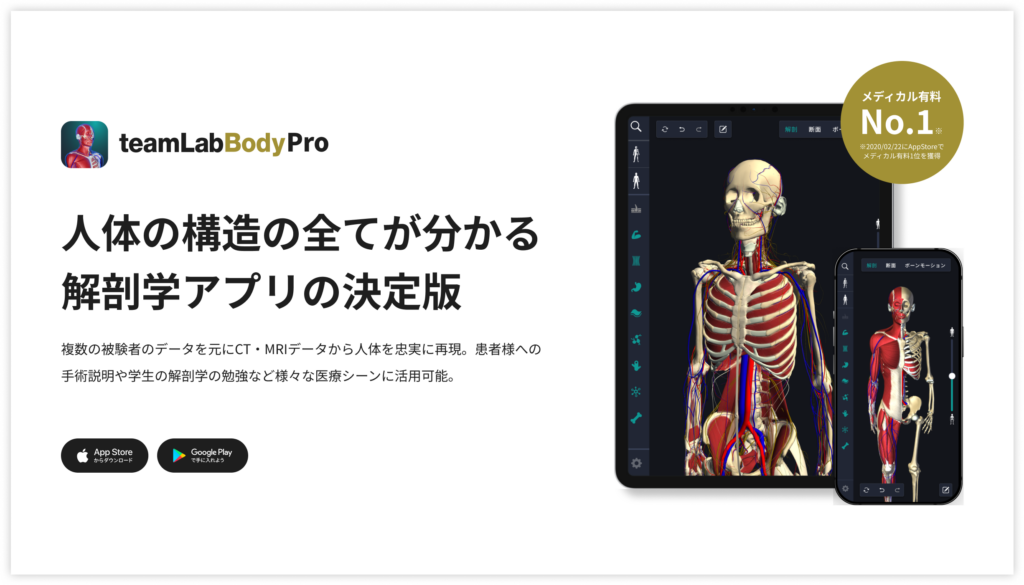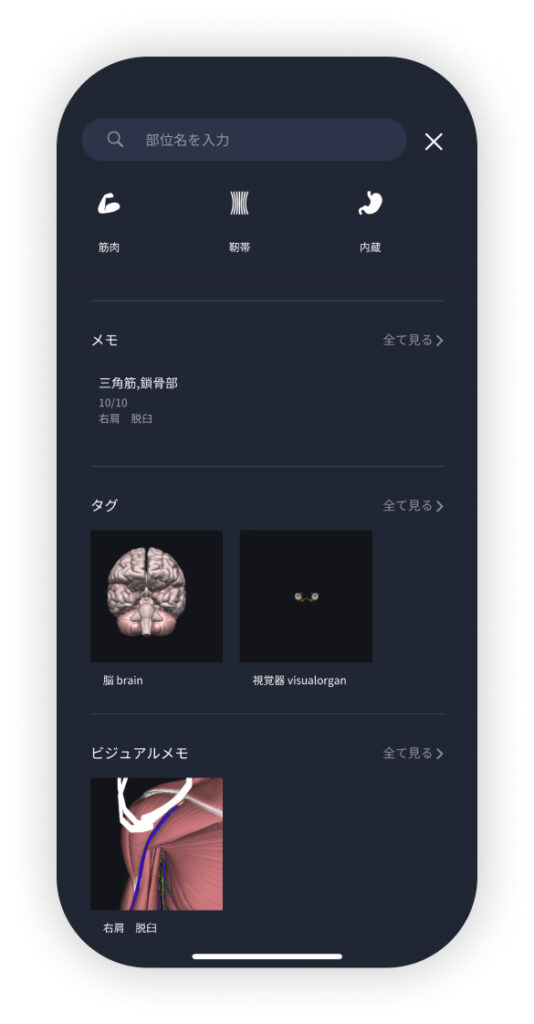beginning
In this article, I will explain effective study methods, starting with knowledge of specialized parts in human anatomy.
In human anatomy, it is necessary not only to memorize the names of various organs, muscles, and bones, but also to remember where they are located in the body. Therefore, it is necessary to learn as efficiently as possible.
I hope you will deepen your understanding even a little by reading this article and using the app.
Now, I will explain the contents of the “nasal cavity” and how to study human anatomy.
teamLab Body Pro Free Download
A 3D anatomy app that shows all the structures of the human body
Download teamLab Body Pro here!

What is nasal cavity?
The anatomy application allows you to view a selection of anatomy 3D models. In this model, there are various observation methods such as surfaces, cross-sections, and nervous systems. This time, I'll explain using an anatomy application.
About the nasal cavity

The nasal cavity is part of the respiratory system and functions as an important passageway connecting the outside world to the body. The main role of the nasal cavity is to humidify, warm, and filter the inhaled air. This improves the quality of air entering the lungs and allows breathing to be carried out smoothly. Also, the nasal cavity is the part that controls the sense of smell, and nerves for detecting odors are gathered.
The nasal cavity starts from the outer nose and is divided into left and right by the nasal septum, and each forms a space called the nasal passage. The upper part of the nasal cavity is the olfactory epithelium that senses smell, and this part is located at the top of the nasal cavity (near the ceiling). There is nasal hair and mucus in the nasal cavity, and these play a role in removing foreign matter and fine particles in the air.
Study points
Anatomical understanding: the structure of the nasal cavity
The nasal cavity continues from the outer nose, and the interior is divided into left and right. A wall made of cartilage and bone called the nasal septum divides the left and right sides, and each forms a space called the nasal passage. The upper part of the nasal cavity is associated with the sense of smell, and there is a special tissue called the olfactory epithelium. The olfactory epithelium is located at the top of the nasal cavity (near the ceiling) and plays a role in detecting odors. In anatomical learning, it is important to accurately memorize the parts that make up the nasal cavity, such as the nasal septum, nasal passages, and olfactory epithelium. For visual understanding, it is effective to use 3D anatomy apps and human models. Also, you can learn more deeply by understanding the inside of the nasal cavity from a cross-sectional perspective and imagining air flow and foreign matter removal functions.
Functional understanding: the role and function of the nasal cavity
The nasal cavity is mainly involved in breathing, and plays a role in humidifying, warming, and delivering inhaled air to the lungs. The function of filtering foreign matter and fine particles in the air is particularly important, and nose hair and mucous membranes achieve this. Also, blood vessels are abundant in the nasal cavity, and these regulate the temperature and prevent cold air from directly reaching the lungs. When learning, you can actually take a deep breath with your nose and feel the temperature and humidity, which deepens your understanding of the function. Furthermore, with regard to smell, if you understand the mechanism by which odor molecules are sensed by the olfactory epithelium, you can more clearly imagine the function of the nasal cavity.
Practical application: understanding nasal diseases
Diseases associated with the nasal cavity include:allergic rhinitisandsinusitisThere is. These diseases affect the function of the nasal cavity. In allergic rhinitis in particular, the nasal mucosa becomes inflamed, narrows the passage of air, and makes breathing difficult. Also, secretions accumulate in the nasal cavity and mucus flow deteriorates, which may cause sinusitis. In sinusitis, pus accumulates due to blockage of the passageway connecting the nasal cavity to the sinuses, causing inflammation. A structural understanding of the nasal cavity is essential for preventing and treating these diseases. In clinical settings, it is necessary to deeply understand how these diseases affect nasal cavity function and take appropriate measures.
How to study human anatomy
I will explain specific study methods using human anatomy applications.
Check your past learning history and practice repeatedly
Here are the steps to check your anatomy learning history and practice iteratively effectively.
1. Check your learning history in the app
Reviewing your learning history with the application is an important step in effectively advancing anatomy learning. First, launch the app and go to the learning history section from the main menu. Many anatomy apps are designed to show your progress in the form of graphs and lists, so you can visually check which parts you've learned about and how much time you've spent.
By using this data, you can understand which areas you have strengths in and where you need to spend more time and effort. We also recommend using a dedicated tag or notebook function to mark areas you are particularly weak at or where you need to relearn. Regularly checking your learning history and looking back on past learning content will lead to efficient review and deepening understanding.
2.Make a plan for iterative learning
Making an efficient repetitive learning plan based on learning history is extremely effective in promoting knowledge retention. First, identify weak points and areas where you need to relearn. Next, arrange these study items into a weekly or monthly calendar and create a specific study schedule. By proceeding in a planned manner, you can learn each part evenly and avoid packing in a large amount of information at once.
Using a task management app or digital calendar to set study reminders is effective. Also, it's important to have the flexibility to regularly review progress and revise plans as needed. By having goals and proceeding with your studies in a planned manner, you can efficiently acquire anatomical knowledge.
3.Use 3D features to learn visually
By utilizing the 3D function, learning anatomy is easier to understand visually. The 3D model shows the structure of the human body three-dimensionally, and each part can be observed in detail. This makes it possible to intuitively grasp positional relationships between deep muscles and organs that are difficult to capture in a planar view. For example, you can learn even the smallest details by rotating specific muscles and bones and zooming in and out.
Also, there are many apps that have the function of displaying cross-sectional views of each part using a 3D model, which is useful for deepening understanding of internal structures. This diversity of visual information helps with memory retention and improves immediate responsiveness in tests and practice situations. By utilizing the 3D function and learning visually, you can learn anatomy knowledge more deeply and efficiently.
Use the memo function concretely

Make notes so you don't forget the things and points you've noticed while studying. The memo function can be used for different purposes, such as inputting text, saving images, and writing memos. Tag your notes to make them easier to review later.
Test your learning regularly in the form of quizzes
Regularly testing what you've learned in a quiz format is a very effective way to anchor your anatomy knowledge. Quiz-style tests help you objectively grasp your level of understanding and areas you lack while repeating knowledge.
For example, by using a learning app to conduct quizzes every specific period, you can reconfirm what you've learned and strengthen your memory. There are a wide range of quiz formats, such as multiple choice questions, fill-in-the-blank questions, and short answer questions, and each helps understanding from a different angle and develops the ability to utilize various types of knowledge.
Get feedback
If possible, get feedback from other learners and experts. It helps you find your own gaps in understanding and areas for improvement. You can also keep yourself motivated to learn by regularly testing yourself. Feeling a sense of accomplishment and progress increases motivation for continuous learning.
summary
This time, I explained how to study about the “nasal cavity” using an application!
Thank you for reading this far.
I would be happy if reading this article helped you learn about anatomy.
Learning is a long, never-ending journey, but I sincerely wish you all the best. Let's continue to study together and work hard for the national exam!
Please look forward to the next blog.
teamLab Body Pro Free Download
A 3D anatomy app that shows all the structures of the human body
Download teamLab Body Pro here!





